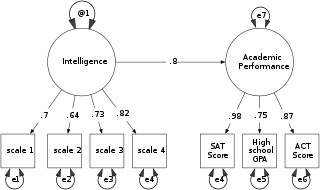Related Research Articles

Social psychology is the scientific study of how thoughts, feelings, and behaviors are influenced by the real or imagined presence of other people or by social norms. Social psychologists typically explain human behavior as a result of the relationship between mental states and social situations, studying the social conditions under which thoughts, feelings, and behaviors occur, and how these variables influence social interactions.

Sociology of religion is the study of the beliefs, practices and organizational forms of religion using the tools and methods of the discipline of sociology. This objective investigation may include the use both of quantitative methods and of qualitative approaches.

Morality is the differentiation of intentions, decisions and actions between those that are distinguished as proper (right) and those that are improper (wrong). Morality can be a body of standards or principles derived from a code of conduct from a particular philosophy, religion or culture, or it can derive from a standard that a person believes should be universal. Morality may also be specifically synonymous with "goodness" or "rightness".
Quality of life (QOL) is defined by the World Health Organization as "an individual's perception of their position in life in the context of the culture and value systems in which they live and in relation to their goals, expectations, standards and concerns". Standard indicators of the quality of life include wealth, employment, the environment, physical and mental health, education, recreation and leisure time, social belonging, religious beliefs, safety, security and freedom. QOL has a wide range of contexts, including the fields of international development, healthcare, politics and employment. Health related QOL (HRQOL) is an evaluation of QOL and its relationship with health.

Social research is a research conducted by social scientists following a systematic plan. Social research methodologies can be classified as quantitative and qualitative.
In sociology, the concept of religiosity has proven difficult to define. The Oxford English Dictionary suggests: "Religiousness; religious feeling or belief. [...] Affected or excessive religiousness". Different scholars have seen this concept as broadly about religious orientations and degrees of involvement or commitment. Religiosity, measured at the levels of individuals or of groups, includes experiential, ritualistic, ideological, intellectual, consequential, creedal, communal, doctrinal, moral, and cultural dimensions. Sociologists of religion have observed that an individual's experience, beliefs, sense of belonging, and behavior often are not congruent with their actual religious behavior, since there is much diversity in how one can be religious or not. Multiple problems exist in measuring religiosity. For instance, measures of variables such as church attendance produce different results when different methods are used - such as traditional surveys vs time-use surveys.

Psychology of religion consists of the application of psychological methods and interpretive frameworks to the diverse contents of religious traditions as well as to both religious and irreligious individuals. The various methods and frameworks can be summarized regarding the classic distinction between the natural-scientific and human-scientific approaches. The first cluster amounts to objective, quantitative, and preferably experimental procedures for testing hypotheses for causal connections among the objects of one's study. In contrast, the human-scientific approach accesses the human world of experience using qualitative, phenomenological, and interpretive methods. The goal of this approach is to discern meaningful, rather than causal, connections among the phenomena one seeks to understand.
Construct validity concerns how well a set of indicators represent or reflect a concept that is not directly measurable. Construct validation is the accumulation of evidence to support the interpretation of what a measure reflects. Modern validity theory defines construct validity as the overarching concern of validity research, subsuming all other types of validity evidence such as content validity and criterion validity.
The study of religiosity and intelligence explores the link between religiosity and intelligence or educational level. Religiosity and intelligence are both complex topics that include diverse variables, and the interactions among those variables are not always well understood. For instance, intelligence is often defined differently by different researchers; also, all scores from intelligence tests are only estimates of intelligence, because one cannot achieve concrete measurements of intelligence due to the concept’s abstract nature. Religiosity is also complex, in that it involves wide variations of interactions of religious beliefs, practices, behaviors, and affiliations, across a diverse array of cultures.

Structural equation modeling (SEM) is a label for a diverse set of methods used by scientists in both experimental and observational research across the sciences, business, and other fields. It is used most in the social and behavioral sciences. A definition of SEM is difficult without reference to highly technical language, but a good starting place is the name itself.

The elaboration likelihood model (ELM) of persuasion is a dual process theory describing the change of attitudes. The ELM was developed by Richard E. Petty and John Cacioppo in 1980. The model aims to explain different ways of processing stimuli, why they are used, and their outcomes on attitude change. The ELM proposes two major routes to persuasion: the central route and the peripheral route.

In statistics, a confounder is a variable that influences both the dependent variable and independent variable, causing a spurious association. Confounding is a causal concept, and as such, cannot be described in terms of correlations or associations. The existence of confounders is an important quantitative explanation why correlation does not imply causation.

Aggregate data is high-level data which is acquired by combining individual-level data. For instance, the output of an industry is an aggregate of the firms’ individual outputs within that industry. Aggregate data are applied in statistics, data warehouses, and in economics.

Temptation is a desire to engage in short-term urges for enjoyment that threatens long-term goals. In the context of some religions, temptation is the inclination to sin. Temptation also describes the coaxing or inducing a person into committing such an act, by manipulation or otherwise of curiosity, desire or fear of loss something important to a person.

The health belief model (HBM) is a social psychological health behavior change model developed to explain and predict health-related behaviors, particularly in regard to the uptake of health services. The HBM was developed in the 1950s by social psychologists at the U.S. Public Health Service and remains one of the best known and most widely used theories in health behavior research. The HBM suggests that people's beliefs about health problems, perceived benefits of action and barriers to action, and self-efficacy explain engagement in health-promoting behavior. A stimulus, or cue to action, must also be present in order to trigger the health-promoting behavior.
Cultural competency training is an instruction to achieve cultural competence and the ability to appreciate and interpret accurately other cultures. In an increasingly globalised world, training in cultural sensitivity to others' cultural identities and how to achieve cultural competence is being practised in the workplace, particularly in healthcare, schools and in other settings.
The intersections of morality and religion involve the relationship between religious views and morals. It is common for religions to have value frameworks regarding personal behavior meant to guide adherents in determining between right and wrong. These include the Triple Gems of Jainism, Islam's Sharia, Catholicism's Catechism, Buddhism's Eightfold Path, and Zoroastrianism's "good thoughts, good words, and good deeds" concept, among others. Various sources - such as holy books, oral and written traditions, and religious leaders - may outline and interpret these frameworks. Some religious systems share tenets with secular value-frameworks such as consequentialism, freethought, and utilitarianism.
Scholarly studies have investigated the effects of religion on health. The World Health Organization (WHO) discerns four dimensions of health, namely physical, social, mental, and spiritual health. Having a religious belief may have both positive and negative impacts on health and morbidity.
Most scientists agree that religiosity is not an independent personality trait, despite there being some commonality between their characteristics. Religiosity and personality traits both relate to one's feelings, thoughts, and behaviors. However, unlike for personality, one's level of religiosity is often measured by the presence or lack of belief in and relationship with a higher power, certain lifestyles or behaviors adopted for a higher power, and a sense of belonging with other followers of one's religion. Additionally, personality traits tend to follow a normal distribution, such that the majority of individuals' scores for a personality trait will be concentrated towards the middle, rather than being extremely high or low. Distributions for religiosity, however, follow a non-normal distribution, such that there are more individuals who score particularly high or low on religiosity scales.

In statistics and research design, an index is a composite statistic – a measure of changes in a representative group of individual data points, or in other words, a compound measure that aggregates multiple indicators.
References
- 1 2 Earl Babbie (1 January 2012). The Practice of Social Research. Cengage Learning. p. 129. ISBN 1-133-04979-6.
- ↑ Hawken, Angela; Munck, Gerardo L. (24 April 2012). "Cross-National Indices with Gender-Differentiated Data: What Do They Measure? How Valid Are They?". Social Indicators Research. 111 (3): 801–838. doi:10.1007/s11205-012-0035-7.